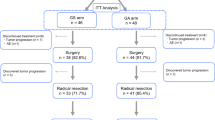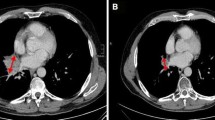Abstract
We herein report the complete remission of multiple recurrent hepatocellular carcinomas (HCCs) by the oral administration of tegafur/uracil (UFT) alone. A 56-year-old Japanese man with two huge HCCs was admitted and underwent hepatic resection. Intraoperative ultrasonography revealed that the tumor thrombus extended to the inferior vena cava (IVC) with a small tumor in the left hepatic lobe. Right trisectionectomy of the liver, removal of the tumor thrombus in the IVC, and partial resection of the left lobe were performed. Microscopic examination revealed that the larger tumor was moderately to poorly differentiated HCC and the smaller tumor was well-differentiated HCC. The small tumor in the left lobe was diagnosed as an intrahepatic metastasis of the larger tumor. Two months after the surgery, computed tomography (CT) revealed multiple HCC recurrences in the remnant liver, but complete remission was achieved by the administration of UFT alone. To clarify the reason for the good response of the recurrent HCC to UFT, the mRNA expression level of several fluoropyrimidine metabolism enzymes was measured in resected specimens. A lower expression of thymidine phosphorylase (TP) might explain the good response to UFT. The patient is alive without intra- or extrahepatic recurrence more than 6 years after the hepatic resection.
Similar content being viewed by others
References
Ishikawa T, Ichida T, Ishimoto Y, et al. (1999) Complete remission of multiple hepatocellular carcinomas associated with hepatitis C virus-related, decompensated liver cirrhosis by oral administration of enteric-coated tegafur/uracil. Am J Gastroenterol 94:1682–1685
Ishikawa T, Ichida T, Sugitani S, et al. (2001) Improved survival with oral administration of enteric-coated tegafur/uracil for advanced stage IV-A hepatocellular carcinoma. J Gastroenterol Hepatol 16:452–459
Matsumoto Y, Fujii H, Matsuda M, et al. (2001) Multicentric occurrence of hepatocellular carcinoma: diagnosis and clinical significance. J Hepatobiliary Pancreat Surg 8:435–440
Liver Cancer Study Group of Japan (2008) The general rules for the clinical and pathological study of primary liver cancer, 5th edn. Kanehara, Tokyo
Horikoshi T, Danenberg KD, Stadlbauer TH, et al. (1992) Quantitation of thymidylate synthase, dihydrofolate reductase, and DTdiaphorase gene expression in human tumors using the polymerase chain reaction. Cancer Res 52:108–116
Salonga D, Danenberg KD, Johnson M, et al. (2000) Colorectal tumors responding to 5-fluorouracil have low gene expression levels of dihydropyrimidine dehydrogenase, thymidylate synthase, and thymidine phosphorylase. Clin Cancer Res 6:1322–1327
Ichikawa W, Uetake H, Shirota Y, et al. (2003) Combination of dihydropyrimidine dehydrogenase and thymidylate synthase gene expressions in primary tumors as predictive parameters for the efficacy of fluoropyrimidine-based chemotherapy for metastatic colorectal cancer. Clin Cancer Res 9:786–791
Kornmann M, Schwabe W, Sander S, et al. (2003) Thymidylate synthase and dihydropyrimidine dehydrogenase mRNA expression levels: predictors for survival in colorectal cancer patients receiving adjuvant 5-fluorouracil. Clin Cancer Res 9:4116–4124
Takahashi T, Yoshida H, Mamada Y, et al. (2007) Profiling of fluorouracil-related genes by microdissection technique in hepatocellular carcinoma. Hepatogastroenterology 54:1612–1616
Ichikawa W, Uetake H, Shirota Y, et al. (2003) Both gene expression for orotate phosphoribosyltransferase and its ratio to dihydropyrimidine dehydrogenase influence outcome following fluoropyrimidine-based chemotherapy for metastatic colorectal cancer. Br J Cancer 89:1486–1492
Miyake K, Imura S, Yoshizumi T, et al. (2007) Role of thymidine phosphorylase and orotate phosphoribosyltransferase mRNA expression and its ratio to dihydropyrimidine dehydrogenase in the prognosis and clinicopathological features of patients with pancreatic cancer. Int J Clin Oncol 12:111–119
Chan GS, Ng WK, Ng IO, et al. (2000) Sudden death from massive pulmonary tumor embolism due to hepatocellular carcinoma. Forensic Sci Int 108:215–221
Ikai I, Yamaoka Y, Yamamoto Y, et al. (1998) Surgical intervention for patients with stage IV-A hepatocellular carcinoma without lymph node metastasis: proposal as a standard therapy. Ann Surg 227:433–439
Author information
Authors and Affiliations
Corresponding author
About this article
Cite this article
Matsuda, M., Shiba, S., Asakawa, M. et al. Complete remission of multiple recurrent hepatocellular carcinomas by oral administration of enteric-coated tegafur/uracil in a patient with huge hepatocellular carcinoma extending to the inferior vena cava after hepatic resection: analysis of mRNA expression of fluoropyrimidine metabolism enzymes in the primary tumor. Int J Clin Oncol 14, 245–248 (2009). https://doi.org/10.1007/s10147-008-0820-0
Received:
Accepted:
Published:
Issue Date:
DOI: https://doi.org/10.1007/s10147-008-0820-0




